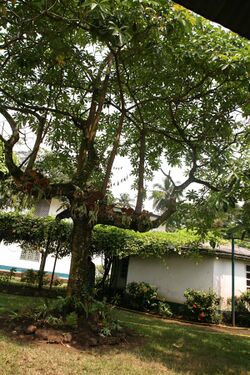Biology:Alstonia congensis
| Alstonia congensis | |
|---|---|

| |
| Scientific classification | |
| Kingdom: | Plantae |
| Clade: | Tracheophytes |
| Clade: | Angiosperms |
| Clade: | Eudicots |
| Clade: | Asterids |
| Order: | Gentianales |
| Family: | Apocynaceae |
| Genus: | Alstonia |
| Species: | A. congensis
|
| Binomial name | |
| Alstonia congensis Engl.
| |
| Synonyms[2][3] | |
|
Alstonia congensis var. glabrata Hutch. & Dalziel | |
Alstonia congensis, is a tree within the Apocynaceae family and one of two African species within the Alstonia genus, the other being the Alstonia boonei De Wild. Both have similar morphological characteristics.
The root and stem bark contains the alkaloids echitamine and echitamidine.[4]
Description
The species can grow as high as 30 meters tall, trunk is cylindrical; bark, smooth or scaly, brown - yellow. Leaves, between 4 and 8 together in verticillate arrangement, petiole, 0-0.5 cm long; leaf-blade, obovate to narrowly obovate in outline, glaucous or coriaceous upper surface, duller beneath, acuminate at apex and decurrent into the base.[5] Flower: sepals, glabrous or sparsely pubescent, pale green.[6]
Distribution
Occurs in West Tropical Africa and parts of Central Africa, particularly the Democratic Republic of Congo,[6] grows in high forest and freshwater swamp forest.[7]
Uses
Leaf and root bark extracts used in the topical treatment of rheumatic pains,[6] root extracts used in decoction to treat mild malaria fever.[8]
References
- ↑ Hills, R. (2019). "Alstonia congensis". IUCN Red List of Threatened Species 2019: e.T60760828A60760831. doi:10.2305/IUCN.UK.2019-3.RLTS.T60760828A60760831.en. https://www.iucnredlist.org/species/60760828/60760831. Retrieved 29 May 2023.
- ↑ "Alstonia congensis Engl.". The Trustees of the Royal Botanic Gardens, Kew. n.d.. https://powo.science.kew.org/taxon/urn:lsid:ipni.org:names:76517-1.
- ↑ "Alstonia congensis Engl.". Species 2000. n.d.. https://www.catalogueoflife.org/data/taxon/C8T5.
- ↑ Caron, Catherine; Graftieaux, Alain; Massiot, Georges; Le Men-Olivier, Louisette; Delaude, Clement (1989). "Alkaloids from Alstonia congensis" (in en). Phytochemistry 28 (4): 1241–1244. doi:10.1016/0031-9422(89)80218-3. Bibcode: 1989PChem..28.1241C. https://linkinghub.elsevier.com/retrieve/pii/0031942289802183.
- ↑ "de Jong, B.H.J. 1979: A revision of the African species of Alstonia R.Br. (Apocynaceae). – Mededelingen Landbouwhogeschool Wageningen 79-13: 1-16 | Flora of Central Africa". http://floreafriquecentrale.org/cdm_dataportal/reference/49bb1006-004c-4811-88cf-0869342092e3.
- ↑ 6.0 6.1 6.2 Monachino, Joseph (1949). "A Revision of the Genus Alstonia (Apocynaceae)" (in en-US). Pacific Science; A Quarterly Devoted to the Biological and Physical Sciences of the Pacific Region. ISSN 0030-8870. http://scholarspace.manoa.hawaii.edu/handle/10125/8927.
- ↑ Jayeola, A. A. (2008-04-18). "Surface sculpturing of Alstonia booneii DE WILD. and A. congensis ENGL. (Apocynaceae) and its importance on their taxonomy" (in en). Feddes Repertorium 109 (5–6): 429–433. doi:10.1002/fedr.19981090514. https://onlinelibrary.wiley.com/doi/10.1002/fedr.19981090514.
- ↑ Cimanga, R. Kanyanga; Nsaka, S. Lumpu; Tshodi, M. Ehata; Mbamu, B. Maya; Kikweta, C. Munduku; Makila, F. Bool-Miting; Cos, Paul; Maes, Louis et al. (2019). "In vitro and in vivo antiplasmodial activity of extracts and isolated constituents of Alstonia congensis root bark" (in en). Journal of Ethnopharmacology 242: 111736. doi:10.1016/j.jep.2019.02.019. PMID 30763695. https://linkinghub.elsevier.com/retrieve/pii/S0378874118349985.
Wikidata ☰ Q15392445 entry
 |


